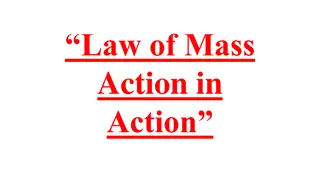Chemical equilibrium
Chemical equilibrium is a state where reactants and products reach a balance in a reaction. Learn about reversible and irreversible reactions, equilibrium constants, and how they affect chemical analysis. Discover the accuracy and applications of volumetric analysis, including titration methods like acid-base, precipitation, and complexometric titrations.
Download Presentation

Please find below an Image/Link to download the presentation.
The content on the website is provided AS IS for your information and personal use only. It may not be sold, licensed, or shared on other websites without obtaining consent from the author.If you encounter any issues during the download, it is possible that the publisher has removed the file from their server.
You are allowed to download the files provided on this website for personal or commercial use, subject to the condition that they are used lawfully. All files are the property of their respective owners.
The content on the website is provided AS IS for your information and personal use only. It may not be sold, licensed, or shared on other websites without obtaining consent from the author.
E N D
Presentation Transcript
Chemical equilibrium Chemical equilibrium In a chemical reaction, chemical equilibrium is the state in which both the reactants and products are present in concentrations which have no further change with time, so that there is no observable change in the properties of the system. A reaction is in chemical equilibrium when the rate of the forward reaction equals the rate of the reverse reaction.
Chemical Reactions Divided into: 1- Irreversible Reactions: A chemical reaction that can occur in one direction reactions, so that the reactants are completely consumed in the reaction and shown by one arrow. HCl + NaOH 2- Reversible Reactions: A chemical reaction that can occur in both directions (the forward and backward directions), so that the reactants are incompletely consumed in the reaction and shown by two arrows CH3COOH + NaOH CH3COONa + H2O NaCl + H2O
Most of the reactions that are useful for chemical analysis proceed rapidly to a state of chemical equilibrium in which reactants and products exist in constant ratios. The knowledge of this ratio permits the chemists to decide whether the reaction is suitable for chemical analysis or not. Equilibrium constant expressions are algebraic equations that relate to the concentrations of reactants or products.
Volumetric analysis ( Volumetric analysis (titration analysis) These are the most useful and accurate analytical techniques, especially for millimole amounts of analyte. They are rapid and can be automated, and they can be applied to smaller amounts of analyte when combined with a sensitive instrumental technique for detecting the completion of the titration reaction, for example, pH measurement. In a titration, the test substance (analyte) in reacts with a reagent added from a burette as a solution of known concentration. This is referred to as a standard solution and is called the titrant. The volume of titrant required to just completely react with the analyte is measured. Since we know the concentration as well as the reaction between the analyte and the reagent, we can calculate the amount of analyte. titration analysis)
Classification of volumetric or titration methods:- (1) Neutralization (acid-base) titrations: Many compounds, both inorganic and organic, are either acids or bases that can be titrated with a standard solution of a strong base or a strong acid. The endpoint of these titrations is easy to detect, either by means of an indicator or by following the change in pH with a pH meter. (2) Precipitation titrations: In the case of precipitation, the titrant forms an insoluble product with the analyte. An example is the titration of chloride ions with silver nitrate solution to form a silver chloride precipitate. (3) Complexometric titrations (sometimes chelatometry) is a form of volumetric analysis in which the formation of a colored complex is used to indicate the end point of a titration. Complexometric titrations are particularly useful for the determination of a mixture of different metal ions in a solution.
(4) Reduction-Oxidation titrations: These (redox) titrations involve the titration of an oxidizing agent with a reducing agent or vice versa . An oxidizing agent gains electrons and a reducing agent loses electrons in a reaction between them.
p-Functions: Scientists frequently express the concentration of a species in terms of its p- function or p-value. The p-value is the negative logarithm (to the base 10) of the molar concentration of that species. Thus, for species X, pX = -log [X] As shown by the following examples, p-values offer the advantage of allowing concentrations that vary over ten or more orders of magnitude to be expressed in terms of small positive numbers.
Example : Calculate the p-value for each ion in a solution that is 2.00 X 10-3M in NaCl and 5.4 X 10-4M in HCl. Solution pH = -log [H+] = -log (5.4 10-4) = 3.27 pNa = -log (2.00 10-3) = -log 2.00 10 3= 2.699 [Cl-] = 2.00 10-3M + 5.4 10-4M =2.00 10 3M + 0.54 10 3M = 2.54 10-3M pCl = -log 2.54 10-3M = 2.595 Example: Calculate the molar concentration of Ag+in a solution that has a pAg of 6.372. Solution: pAg = -log [Ag+] = 6.372, log [Ag+] = -6.372, [Ag +] = 4.246 10-7= 4.25 10-7
Materials in its aquase solution classified into two types: Electrolytes and non Electrolytes All substances that dissociate in water into ions are called electrolytes or ionic substance, those do not dissociate are termed non-electrolytes or nonionic substance. Aqueous solutions of electrolytes conduct an electric currant, but those of non- electrolytes do not. Electrolytes are classified as Strong or Weak. A. Strong Electrolyte materials Materials that totally ionized in their aqueous solutions are called strong electrolytes. These electrolytes are good electricity conductors, high solubility, such as strong acids and bases. HCl NaOH Ca(OH)2 NaCl H++ Cl- Na++ OH- Ca2+ + 2OH- Na++ Cl-
B. Weak electrolyte materials Materials that partially ionized in their aqueous solutions, reaching ionic equilibrium called weak electrolytes. These electrolytes are weak electricity conductors such as weak acids and bases. HCN H+ + CN- CH3COOH CH3COO-+ H+ NH4OH NH4++ OH- The dissociation or ionization of weak electrolytes is quantitatively described by equilibrium constant. Suppose the dissociation of AB. AB A + B The equilibrium constant Ke of the dissociation is generally written as: Ke = ------------- [A] [B] [AB]
NON ELECTROLYTE MATERIALS These are the materials that do not release any ions in their aqueous solutions such as ethanol. C2H5OH C2H5OH Glucose Glucose
ACIDS AND BASES 1.Arrhenius concept Acid is a material that ionized in water to give hydrogen ion. Base is a material that ionized in water to give hydroxide ion. HCl H+ + Cl-, NaOH Na++ OH- 2.Bronsted and Lowry concept Acid is any substance that is capable of donating proton wherase base is any substance can accept a proten. Acid base + proton CH3COOH + H2O CH3COO-+ H3O+ acid-1 base-2 base-1 acid-2
HNO3 Acid-1 base-2 base-1 acid-2 NH3 + H2O NH4+ base -1 acid -2 acid-1 base-1 water is amphprotic solvent because it exhibits both acidic and basic properties. After an acid has donate a proton the species that remains is capable of accepting proton to reform the original acid then every acid is paired with its corresponding base which is called as conjugate base. + H2O No3- + H3O+ Conjugate Conjugate Base Acid + OH- Conjugate Conjugate Acid Base
























